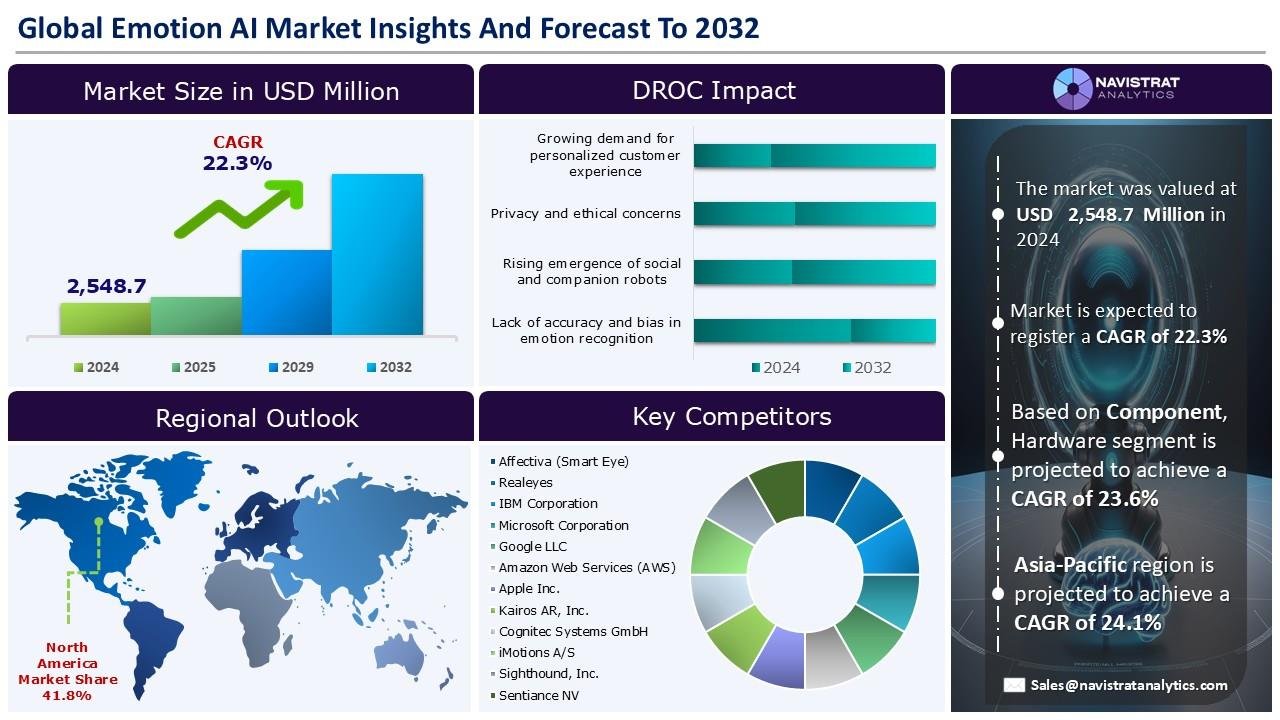In June 2024, researchers at Huazhong University of Science and Technology achieved a significant breakthrough in emotion recognition technology by creating an advanced system that could transform human-machine interaction and mental health monitoring. This state-of-the-art innovation, known as Domain Generalization and Residual Network-Based Emotion Recognition from Physiological Signals (DGR-ERPS), leverages complex physiological signals to accurately detect and interpret human emotions.
However, privacy and ethical concerns are major challenges limiting the revenue growth of the emotion AI market. Since these technologies rely on collecting and analyzing sensitive emotional data, issues related to user consent, data security, and potential misuse are becoming increasingly prominent. Regulations such as GDPR and other data protection laws enforce strict guidelines on data collection, storage, and usage, making it more complex for companies to deploy emotion AI solutions.
Segment market overview and growth insights:
Based on the component, the global Emotion AI market is segmented into hardware, software and services. The software segment held the largest market share in 2024, driven by the growing demand for advanced emotion detection and analysis tools across multiple industries. Companies and organizations are increasingly leveraging these solutions to enhance customer experiences, boost engagement, and tailor services to individual needs. Emotion AI software enables real-time sentiment analysis, behavioral forecasting, and emotional insights, making it a crucial tool for applications in customer service, marketing, mental health, and entertainment.
For example, in October 2024, the global creative effectiveness platform DAIVID launched an AI-powered self-service solution designed to predict the emotions and attention an advertisement will generate, along with its potential impact on brand and business metrics. Named DAIVID Self-Serve, this tool utilizes a predictive algorithm to deliver advertisers rapid insights into the emotional and commercial effects of a video or image within minutes, eliminating the need for audience panels.
Regional market overview and growth insights:
European market held a substantial revenue share in 2024, driven by advancements in AI research, favorable regulatory frameworks, and the growing adoption of Emotion AI across various industries, particularly in Germany, the UK, and France. Businesses in the region are leveraging Emotion AI to enhance customer engagement, refine marketing strategies, and improve operational efficiency in sectors such as retail, healthcare, and automotive.
Nottingham-based UK startup BlueSkeye AI is at the forefront of Emotion AI innovation, aiming to transform mental health diagnosis through its advanced facial tracking technology. Currently, the company’s specialized technology is undergoing clinical trials in the UK to assess its effectiveness in interpreting emotions and evaluating mental health, with a particular focus on pregnancy-related assessments.
Competitive Landscape and Key Competitors:
The Emotion AI market is characterized by a fragmented structure, with many competitors holding a significant share of the market. List of major players included in the Emotion AI market report are:
o Affectiva (Smart Eye)
o Realeyes
o IBM Corporation
o Microsoft Corporation
o Google LLC
o Amazon Web Services (AWS)
o Apple Inc.
o Kairos AR, Inc.
o Cognitec Systems GmbH
o Synthesia
o Sighthound, Inc.
o Sentiance NV
o Emotibot Technologies Limited
o Qemotion
Major strategic developments by leading competitors:
Affectiva: On October 3, 2024, Affectiva, a Smart Eye company and a global pioneer in Emotion AI, announced a three-year extension of its longstanding partnership with Kantar, a leading global marketing data and analytics firm. This collaboration, which has spanned more than a decade, underscores Kantar’s confidence in Affectiva’s technology for delivering accurate and in-depth attention and emotional insights. The renewed agreement enables both companies to address the increasing demand for facial coding in advertising, media, and market research.
Synthesia: On April 25, 2024, Nvidia-backed AI company Synthesia unveiled a new generation of AI-generated digital avatars designed to convey human emotions through text inputs. Known as “Expressive Avatars,” these advanced creations are intended to narrow the divide between virtual beings and real-world personalities.
Navistrat Analytics has segmented global Emotion AI market on the basis of component, deployment, technology, application, end-use, and region:
• Component Outlook (Revenue, USD Million; 2022-2032)
o Hardware
o Software
o Service
• Deployment Outlook (Revenue, USD Million; 2022-2032)
o On-Premises
o Cloud-Based
• Technology (Revenue, USD Million; 2022-2032)
o Facial Expression Recognition
o Speech/Voice Recognition
o Natural Language Processing (NLP)
o Physiological Signal Sensing
o Others
• Application (Revenue, USD Million; 2022-2032)
o Customer Experience Management (CXM)
o Sentiment Analysis
o Engagement Analysis
o Human-Robot Interaction Optimization
o Consumer Behavior Analysis
o Audience Emotion Tracking
o Others
• End-Use Outlook (Revenue, USD Million; 2022-2032)
o Retail & E-Commerce
o BFSI (Banking, Financial Services, and Insurance)
o IT & Telecom
o Automotive
o Healthcare
o Education
o Media and Entertainment
o Others
• Regional Outlook (Revenue, USD Million; 2022-2032)
o North America
a. U.S.
b. Canada
c. Mexico
o Europe
a. Germany
b. France
c. U.K.
d. Italy
e. Spain
f. Benelux
g. Nordic Countries
h. Rest of Europe
o Asia Pacific
a. China
b. India
c. Japan
d. South Korea
e. Oceania
f. ASEAN Countries
g. Rest of APAC
o Latin America
a. Brazil
b. Rest of LATAM
o Middle East & Africa
a. GCC Countries
b. South Africa
c. Israel
d. Turkey
e. Rest of MEA
Get a preview of the complete research study:
~Navistrat Analytics~
MENAFN03082025008152017457ID1109877554




